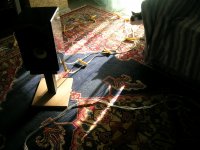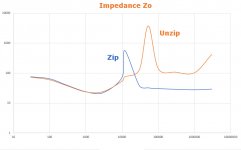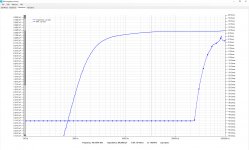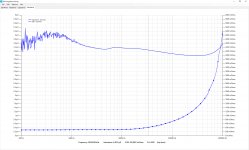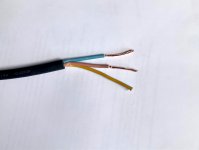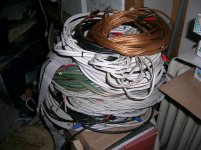Waitaminute..... the cables are touching the rug????
Where are your lifters???
I was quite surprised at the split impedance.
Jn
Measure the L and C.....to verify consistency with RFZ.
Where are your lifters???
I was quite surprised at the split impedance.
Jn
Measure the L and C.....to verify consistency with RFZ.
Last edited:
I thougt the idea was to split the cables for one side only and leave the the zips for the other side intact.
On the picture it looks as if both sides were split ?
Hans
On the picture it looks as if both sides were split ?
Hans
Waitaminute.....
And don’t you ever again call my wife’s precious (*) carpet a ‘rug’
Persian carpets are well known for their vibration damping and antitriboelectric properties, the perfect Hi-End cable lifter.
Then the 3 inch spacers are made from a space-age material, direct out from secret labs. I painted it yellow for not to attract attention from the intelligence community.
Hans, the other bundle is 4 zip cords unsplit
George
(*) it smells wool when it comes in contact with the soldering iron
Attachments
I used the LCR meter DER5000. The measurements at 100kHz are the most consistent.I was quite surprised at the split impedance.
Measure the L and C.....to verify consistency with RFZ.
L measured with far end of the cable shorted.
C measured with far end of the cable open
RFZ= SQRT(Ls/Cs)
Single zip: 132 Ohm
4 zips paralleled: 35 Ohm
4 zips split and spaced 3 inches: 447 Ohm
At 100kHz even using any of the Ls, Lp, Cs, Cp readings, ends in an RFZ very close (+/- 5%) to the Ls/Cs value.
RFZ using the TDR method (less time consuming)
Single zip: 155 Ohm
4 zips paralleled: 38 Ohm
4 zips split and spaced 3 inches: 443 Ohm
Tomorrow I’ll review and post the REW impedance sweeps
Hans, how did you produce these Zo traces? They look a bit strange
George
Those numbers are far more consistent with my understandings. The 100 ohm you earlier stated for the unzipped was not feeling "right". The 443 value is much better.
Would you perchance have the impedance plot of the speaker?
John
Would you perchance have the impedance plot of the speaker?
John
The 100 ohm was with the split wires unconstrained as seen at post 84. Zip cord for speaker test
The impedance of the speaker is at post 82 Zip cord for speaker test
George
The impedance of the speaker is at post 82 Zip cord for speaker test
George
I agree that the traces are looking weird, but that's what my VNA setup returned.I used the LCR meter DER5000. The measurements at 100kHz are the most consistent.
L measured with far end of the cable shorted.
C measured with far end of the cable open
RFZ= SQRT(Ls/Cs)
Single zip: 132 Ohm
4 zips paralleled: 35 Ohm
4 zips split and spaced 3 inches: 447 Ohm
At 100kHz even using any of the Ls, Lp, Cs, Cp readings, ends in an RFZ very close (+/- 5%) to the Ls/Cs value.
RFZ using the TDR method (less time consuming)
Single zip: 155 Ohm
4 zips paralleled: 38 Ohm
4 zips split and spaced 3 inches: 443 Ohm
Tomorrow I’ll review and post the REW impedance sweeps
Hans, how did you produce these Zo traces? They look a bit strange
George
Zipped at 100Khz: 4,3uH+275pF resulting in 31R for 4 zips, close to your result.
Unzipped at 100Kz and spaced far apart: 16uH+34pF resulting in 171R for 4 unzipped.
The 275pF and 34pF being already corrected for the 15pF probe.
But that is just for one single frequency, and taking Zo=sqrt(Zopen*Zshort) gives an exact result because it also takes into account the R and the G of Zo=Sqrt[(R+L)/(G+C)].
Hans
.
Attachments
George,
Looking at the above images:
At 12Khz for the zip version, L=4,3uH and C measures 0pF.
Same for unzip at 63kHz, L=16uH and C measures 0pF.
So taking Zo=sqrt(L/C) leads in both cases to infinity.
Only G is preventing this from happening, but still results in a high impedance, as can be seen here
Zip cord for speaker test
That your unzipped impedance is so much higher, means that you are closer to the point where C measures 0pF.
Hans
Looking at the above images:
At 12Khz for the zip version, L=4,3uH and C measures 0pF.
Same for unzip at 63kHz, L=16uH and C measures 0pF.
So taking Zo=sqrt(L/C) leads in both cases to infinity.
Only G is preventing this from happening, but still results in a high impedance, as can be seen here
Zip cord for speaker test
That your unzipped impedance is so much higher, means that you are closer to the point where C measures 0pF.
Hans
Last edited:
I used a zip cord with 25*0.15mm strands, giving roughly the same total surface of 0.5 mm^2 as 15*0.18mm.
But in my case the cable was was made from tinned copper strands.
I don’t know whether this could make a difference, but that was all I could get.
Hans
But in my case the cable was was made from tinned copper strands.
I don’t know whether this could make a difference, but that was all I could get.
Hans
I used a zip cord with
Hi Hans
So there are three up to now who have gone down the rabbit hole (John is out of the counting. He's the one who dug the hole)
But that is just for one single frequency, and taking Zo=sqrt(Zopen*Zshort) gives an exact result because it also takes into account the R and the G of Zo=Sqrt[(R+L)/(G+C)].
Thanks
I thought the Z plots were a result of simulation.
The discontinuities are a result of calculation. I agree that the later formula is the one to use.
R and L from short end measurement
G and C from open end measurement
George
Hi George,
I'm rather surprised by the odd characteristics of this zip cord.
The cable that I showed here with the yellow trace
Zip cord for speaker test
was a 45*0.2mm or 1.5mm^2 power cord, internally twisted, of which I only used 2 of the 3 conductors, see image below.
This cable obviously has a "decent" char. imp. gradient versus frequency without the large peaks of the zip chord.
However, since this cable subjectively produced inferior sound to the MH-770, it would probably be a complete waste of money to repeat John's test with this cable.
Hans
.
I'm rather surprised by the odd characteristics of this zip cord.
The cable that I showed here with the yellow trace
Zip cord for speaker test
was a 45*0.2mm or 1.5mm^2 power cord, internally twisted, of which I only used 2 of the 3 conductors, see image below.
This cable obviously has a "decent" char. imp. gradient versus frequency without the large peaks of the zip chord.
However, since this cable subjectively produced inferior sound to the MH-770, it would probably be a complete waste of money to repeat John's test with this cable.
Hans
.
Attachments
any of you have star quad or star hex configured cable to analyze? Jneutron have you any theory or opinions on this configuration? Same for various interconnections of cat5 or cat 6 as two conductor speaker cable.
any of you have star quad or star hex configured cable to analyze? Jneutron have you any theory or opinions on this configuration? Same for various interconnections of cat5 or cat 6 as two conductor speaker cable.
Cat 5 and 6 cables are 100 ohm pairs, and by design they are twisted orthogonally, so that each pair does not magnetically communicate with any other. So paralleling those twisted pairs, means the final impedance will be 100/N, with N being the number of pairs connected.
I don't care for the cat cable overall conductor size however.
Four conductors arranged in quadrature (as in two zips tied together in antiparallel, will have a lower external magnetic field so will have a lower impedance than a single zip. I suspect it will halve the impedance, but there actually may be a bit more reduction as a quadrupole field drops to zero in the exact center. I've not tried to measure it, but it is interesting. If it drops impedance more that 3 times, it might just be a simpler way to tie wrap two zips together antiparallel...
I just designed a cable tray run using a star quad arrangement using 4 535 kcmil wires to keep the external magnetic field down.
Starhex? That's a new one on me..sextupole fields are even less storage than quadrupoles, but it's not a geometically stable configuration unless you put a same diameter core that the 6 go around. If you make the core slightly larger than the outer 6 conductors, then there will be an optimal twist pitch that keeps the cable nice and tight. A good application for PLA filament, it comes in 1.75mm and 3mm. Fishing lines are all over the range.
I use "6 around 1" superconductors on my machines, so have a lot of experience with that mechanical geometry.
jn
Last edited:
Properly constructed star-quad speaker cable is hard to beat. Much of it isn't constructed that well unfortunately. Twist rate, mechanical stability, dielectric type, they all matter.
Hans, no. Stick to the cheap zip please.
Who’s talking!
an accumulation of uncompleted work or matters needing to be dealt with. (defininion of 'backlog')
As if I haven’t pilled enough since 2014
George
Wow, that’s a huge pile. 😀 😀
Hans
Matter in what way?Properly constructed star-quad speaker cable is hard to beat. Much of it isn't constructed that well unfortunately. Twist rate, mechanical stability, dielectric type, they all matter.
- Home
- General Interest
- Everything Else
- Zip cord for speaker test
